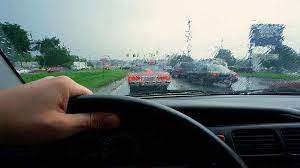Driving in the rain can be challenging, especially if you’re not used to it. Rain can make the roads slick, reduce visibility, and increase the risk of hydroplaning. However, with the right knowledge and precautions, you can stay safe while driving in the rain. In this article, we’ll discuss some essential safety tips for driving in the rain.
- Check Your Vehicle
Before driving in the rain, it’s crucial to make sure your vehicle is in good condition. Check the windshield wipers to ensure they’re working correctly, and replace them if necessary. Also, check the headlights, brake lights, and turn signals to ensure they’re functioning correctly. Make sure the tires have enough tread and are inflated to the proper pressure. It’s essential to keep your vehicle maintained to ensure it’s safe to drive in any condition.
- Slow Down
When driving in the rain, it’s essential to slow down. Wet roads reduce traction, making it more challenging to stop or turn quickly. Reduced visibility also means you may not see hazards until it’s too late, so slowing down can give you more time to react. Keep in mind that posted speed limits are designed for dry conditions, and it’s safer to drive slower in the rain.
- Increase Following Distance
When driving in the rain, it’s essential to increase your following distance. Wet roads increase stopping distance, so it’s crucial to give yourself more room to stop. A general rule of thumb is to increase following distance from the typical three-second rule to a five or six-second rule. To determine your following distance, choose a fixed object on the road ahead, such as a sign or a tree. When the vehicle ahead of you passes the object, start counting how long it takes for your vehicle to reach the same object. If it’s less than five seconds, you’re following too closely.
- Turn On Your Headlights
Turning on your headlights is essential when driving in the rain, even during the day. Headlights increase visibility and make it easier for other drivers to see you. In many states, it’s the law to turn on your headlights when using windshield wipers. If your vehicle has fog lights, you can also use them in the rain to improve visibility.
- Avoid Sudden Movements
When driving in the rain, it’s essential to avoid sudden movements, such as hard braking or sharp turns. Wet roads reduce traction, making it more challenging to control your vehicle. Sudden movements can cause your vehicle to skid or hydroplane, increasing the risk of an accident. If you need to slow down or turn, do so gradually and smoothly.
- Avoid Hydroplaning
Hydroplaning occurs when your tires lose contact with the road and glide on a layer of water. It’s a significant risk when driving in the rain, especially at high speeds. To avoid hydroplaning, it’s essential to slow down and increase following distance. Avoid puddles and standing water, as they can cause hydroplaning. If you do start to hydroplane, avoid sudden movements, such as braking or turning. Instead, ease off the accelerator and steer straight until your tires regain traction.
- Use Your Defroster
Rain can cause your windshield to fog up, reducing visibility. To prevent fogging, use your defroster to keep the windshield clear. You can also crack a window slightly to allow fresh air to circulate, reducing moisture buildup.
- Watch for Standing Water
Standing water can be challenging to see, especially at night. Avoid driving through standing water, as it can cause hydroplaning or damage to your vehicle. If you must drive through standing water, proceed slowly and cautiously. If you can’t see the bottom of the water, it’s best to find an alternate
 Lifeyet News Lifeyet News
Lifeyet News Lifeyet News





